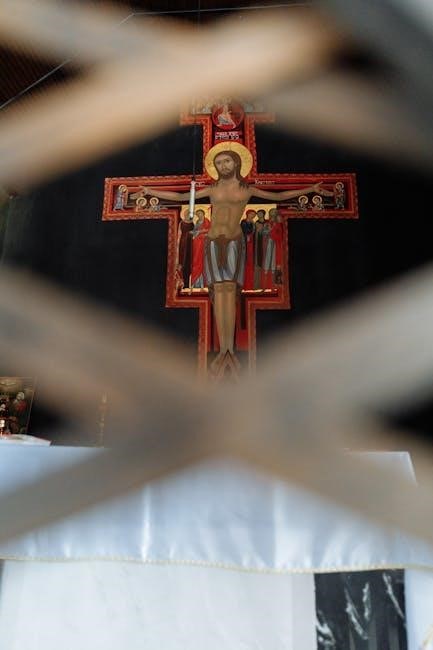The Stations of the Cross is a prayerful devotion following Jesus’ journey to Calvary, with
- scriptural reflections
and prayers, typically observed on Fridays during Lent, in a series of fourteen stations.
History and Tradition of the Stations of the Cross
The Stations of the Cross have a long history, dating back to the early Christian Church, with the tradition of following Jesus’ journey to Calvary originating in Jerusalem, where pilgrims would retrace the steps of Jesus, praying and reflecting on his passion and death, and this devotion was later adopted by churches in Europe and around the world, with the Stations of the Cross becoming a popular Lenten devotion, observed on Fridays during Lent, with many churches and cathedrals having Stations of the Cross, often with beautiful works of art and architecture, and the stations are typically prayed in a series of fourteen, with each station representing a different event in Jesus’ journey to Calvary, from his condemnation to his burial, and the prayers and reflections for each station are often based on scripture and tradition, with the goal of helping the faithful to deepen their understanding and devotion to Jesus and his passion, and to reflect on the meaning and significance of his death and resurrection, and the tradition of the Stations of the Cross continues to be an important part of Christian devotion and spirituality, with many people finding comfort, peace, and inspiration in praying the Stations of the Cross, and the tradition is also a reminder of the importance of prayer, reflection, and devotion in the Christian life, and the Stations of the Cross are often prayed in community, with many churches and parishes offering Stations of the Cross services during Lent, and the tradition is also a way to connect with the global Christian community, and to participate in a devotion that is shared by Christians around the world, and the Stations of the Cross are a powerful reminder of the love and sacrifice of Jesus, and the importance of living a life of faith, hope, and charity, and the tradition continues to inspire and guide Christians today, with its rich history, beautiful artwork, and profound spiritual significance, and the Stations of the Cross remain an essential part of Christian devotion and spirituality, and a powerful way to deepen one’s faith and connection with God, and the prayers and reflections of the Stations of the Cross offer a unique and meaningful way to observe Lent, and to prepare for the joy and celebration of Easter, and the tradition of the Stations of the Cross is a treasure of the Christian faith, and a gift to all who pray it, and the Stations of the Cross are a reminder of the importance of living a life of love, compassion, and service, and the tradition continues to inspire and guide Christians today, with its message of hope, redemption, and salvation, and the Stations of the Cross are a powerful reminder of the enduring power of faith, and the importance of living a life of devotion, prayer, and service, and the tradition of the Stations of the Cross is a testament to the enduring power of love, and the human spirit, and the Stations of the Cross are a reminder of the importance of living a life of faith, hope, and charity, and the tradition continues to inspire and guide Christians today, with its rich history, beautiful artwork, and profound spiritual significance, and the Stations of the Cross remain an essential part of Christian devotion and spirituality, and a powerful way to deepen one’s faith and connection with God, and the prayers and reflections of the Stations of the Cross offer a unique and meaningful way to observe Lent, and to prepare for the joy and celebration of Easter, and the tradition of the Stations of the Cross is a treasure of the Christian faith, and a gift to all who pray it, and the Stations of the Cross are a reminder of the importance of living a life of love, compassion, and service, and the tradition continues to inspire and guide Christians today, with its message of hope, redemption, and salvation, and the Stations of the Cross are a powerful reminder of the enduring power of faith, and the importance of living a life of devotion, prayer, and service.

Using the Stations of the Cross Booklet
A period of silence is observed between Scripture reading and prayer, with a crossbearer and candlebearers moving between stations, singing a verse of the Stabat Mater, following the booklet guidance carefully always.
Scriptural Reflections and Prayers
The scriptural reflections and prayers are an essential part of the Stations of the Cross devotion, allowing individuals to meditate on the passion and death of Jesus Christ. The reflections are typically based on Scripture readings, such as John 19:1-3, and are accompanied by prayers that encourage individuals to acknowledge their feelings and offer them to God. The prayers and reflections are designed to help individuals understand the significance of Jesus’ journey to Calvary and to apply the lessons of his passion and death to their own lives. The use of Scripture readings and prayers helps to create a sense of intimacy and connection with God, and allows individuals to reflect on their own relationship with Him. The reflections and prayers are often accompanied by images or icons of the Stations of the Cross, which serve as a visual reminder of the events of Jesus’ passion and death. By using the scriptural reflections and prayers, individuals can deepen their understanding of the Stations of the Cross and cultivate a greater sense of devotion and spirituality. The reflections and prayers can be used in a variety of settings, including personal prayer, group devotion, and communal worship.

Reflections on the Stations of the Cross
Personal reflections on the Stations of the Cross offer a meaningful way to contemplate Jesus’ journey, using scripture and prayer to deepen spiritual understanding and connection.
Images of the Stations of the Cross
The images of the Stations of the Cross are a visual representation of Jesus’ journey to Calvary, depicting the events from his condemnation to his burial. These images are often displayed in churches and are used as a focal point for prayer and reflection. The images can be in the form of paintings, sculptures, or other artworks, and are typically arranged in a sequence of fourteen stations. Each station is accompanied by a prayer and reflection, and the images serve as a reminder of the events of Jesus’ passion. The use of images in the Stations of the Cross can be a powerful way to engage with the story of Jesus’ journey, and can help to deepen one’s understanding and connection to the story. The images can also be used in conjunction with the prayers and reflections to create a meaningful and contemplative experience.

Practicing the Stations of the Cross
Practicing the Stations involves
- prayer
and reflection, typically on Fridays during Lent, to deepen one’s faith and connection to Jesus’ journey, with a crossbearer and candlebearers accompanying each station.
and Final Reflection
The Stations of the Cross prayers and reflections provide a meaningful way to deepen one’s faith and connection to Jesus’ journey. By observing the fourteen stations, individuals can reflect on the significance of Jesus’ sacrifice and resurrection. The use of scriptural reflections and prayers, such as those found in the Stations of the Cross booklet, can facilitate a more personal and intimate experience. The images of the Stations of the Cross, such as those created by Ken Cooke, can also serve as a powerful reminder of the events of Jesus’ Passion. As individuals conclude their observation of the Stations of the Cross, they are encouraged to reflect on the ways in which they can apply the lessons of Jesus’ journey to their own lives. By doing so, they can cultivate a deeper sense of spirituality and connection to their faith. The Stations of the Cross prayers and reflections offer a profound and meaningful way to observe the Lenten season.

Availability of Stations of the Cross Resources
Stations of the Cross resources, including booklets and images, are available online and in churches, providing access to prayers and reflections for individuals and communities to observe Lent.
Final Thoughts on the Stations of the Cross
The Stations of the Cross offer a meaningful way to reflect on Jesus’ journey to Calvary, inviting individuals to pray and meditate on the significance of his sacrifice. Through scriptural reflections and prayers, participants can deepen their understanding of the Passion and Resurrection. The availability of Stations of the Cross resources, including booklets and images, provides a convenient way to observe this devotion. By incorporating the Stations into their Lenten practices, individuals can cultivate a sense of spiritual growth and renewal. The prayers and reflections associated with each station encourage believers to acknowledge their feelings and offer them to God, secure in the knowledge that fear and isolation are not the final word. Ultimately, the Stations of the Cross remind us that the Way of the Cross is also the Way of Life and Resurrection, offering a powerful symbol of hope and redemption. This devotion can be a valuable tool for spiritual growth and development, especially during the Lenten season.




Leave a Reply
You must be logged in to post a comment.